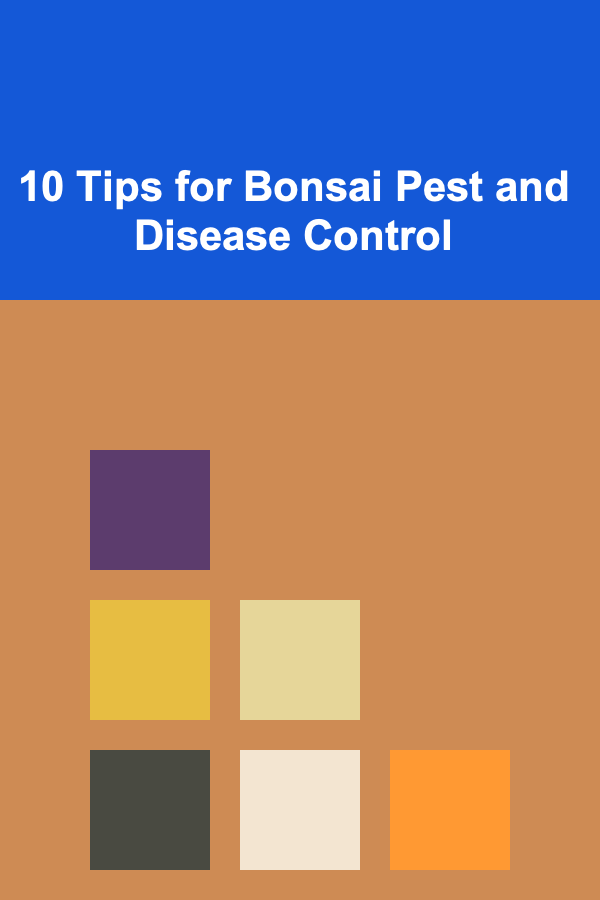
10 Tips for Bonsai Pest and Disease Control
ebook include PDF & Audio bundle (Micro Guide)
$12.99$11.99
Limited Time Offer! Order within the next:

Bonsai trees are a unique and rewarding aspect of gardening that requires a certain level of care and attention. Whether you're a seasoned bonsai enthusiast or a beginner, it's important to keep your bonsai healthy to ensure it thrives for many years. One of the most critical aspects of bonsai care is pest and disease control. Pests and diseases can quickly damage or kill a bonsai if not addressed in time. Therefore, understanding how to manage these issues is essential for every bonsai grower.
In this article, we will explore ten tips for effectively controlling pests and diseases in bonsai trees. These tips will help you not only protect your tree from harm but also create a healthier growing environment for your bonsai.
1. Regularly Inspect Your Bonsai Trees
Prevention is always better than cure, and one of the most effective ways to manage pests and diseases is through regular inspection of your bonsai trees. It's important to check for any signs of infestation or illness on a consistent basis. This should be done at least once a week, though more frequent checks are recommended if your tree is particularly susceptible.
Look for the following indicators:
- Discoloration of leaves: Yellowing or browning can indicate stress or disease.
- Sticky residue: This could be a sign of aphids or scale insects.
- Spots or holes on leaves: These might be caused by pests such as caterpillars or mites.
- Visible insects: Aphids, spider mites, whiteflies, and other pests can often be seen on the surface of leaves and stems.
By catching problems early, you can take immediate action and prevent more serious damage.
2. Use Organic Pest Control Methods
When dealing with pests on your bonsai, using organic pest control methods is often the safest approach. Chemical pesticides can harm the health of your bonsai and also affect the surrounding environment. Here are some organic solutions to consider:
- Neem oil: Neem oil is an effective natural pesticide that can control a variety of pests, including aphids, spider mites, and whiteflies. It also acts as a fungicide to protect against certain fungal diseases.
- Insecticidal soap: These soaps are mild but effective against soft-bodied insects such as aphids and mealybugs. They work by breaking down the outer shells of insects, causing them to dehydrate.
- Diatomaceous earth: This fine powder is made from the fossilized remains of tiny organisms and can be sprinkled on your bonsai soil to deter pests like slugs, ants, and beetles.
Before applying any of these organic treatments, make sure to test them on a small section of your tree to ensure they do not cause damage.
3. Maintain Proper Watering Practices
Overwatering or underwatering can create an environment conducive to pests and diseases. When you water your bonsai, make sure to:
- Water deeply but infrequently to encourage deep root growth and prevent fungal growth.
- Avoid letting the water sit in the saucer under your bonsai pot, as stagnant water can attract pests like mosquitoes and promote mold growth.
- Always use well-draining soil to prevent water from pooling around the roots, as soggy conditions can lead to root rot and fungal infections.
Proper watering not only ensures your bonsai is healthy but also reduces the likelihood of attracting pests like root aphids and fungus gnats, which thrive in moist conditions.
4. Ensure Proper Air Circulation
Good air circulation is crucial for the health of any plant, but it's especially important for bonsai trees. Poor air circulation creates a humid environment that is conducive to the growth of mold, fungi, and bacteria, all of which can lead to diseases. Stagnant air also encourages pests such as spider mites and aphids to thrive.
To improve airflow around your bonsai:
- Place your tree in a location where air can flow freely.
- Use a small fan if necessary, particularly in rooms with little ventilation.
- Avoid overcrowding your bonsai with other plants, as this can restrict airflow.
Good air circulation not only helps prevent pests but also strengthens the tree's overall immune system, allowing it to better defend against potential threats.
5. Keep the Bonsai Area Clean
Cleaning the area around your bonsai is an often-overlooked but essential task in pest and disease control. Fallen leaves, dead wood, and other organic matter can harbor pests and diseases that can spread to your bonsai. Cleaning the surrounding area helps eliminate any potential sources of infestation.
Here's what you can do:
- Remove dead leaves or branches regularly.
- Clean the surface of your bonsai pot and surrounding area to avoid the buildup of debris.
- Disinfect your bonsai tools after each use to prevent the spread of pathogens.
A clean environment reduces the chance of pest outbreaks and helps keep your tree healthy.
6. Avoid Overcrowding Your Bonsai
Overcrowding your bonsai or placing it near other infected plants can increase the risk of pest and disease problems. Pests such as aphids, mealybugs, and scale insects can easily move from one plant to another, and disease-causing fungi and bacteria can spread in humid, crowded environments.
Make sure that your bonsai has enough space to grow and breathe, both for its own health and to reduce the risk of pest infestations. If you grow multiple bonsai trees, try to give each one adequate space to prevent the spread of pests and diseases.
7. Fungal and Bacterial Disease Prevention
Fungal and bacterial infections are common problems for bonsai trees. Common issues include powdery mildew, black spot fungus, and root rot. Here's how to prevent and treat them:
- Avoid excess moisture: Wet conditions, especially in poorly drained soil, promote fungal growth. Be mindful of your watering habits and make sure the bonsai's soil is well-drained.
- Use fungicides: Organic fungicides such as copper-based sprays or sulfur can be effective in treating fungal infections.
- Remove infected parts: If you notice any signs of disease, prune the affected branches, leaves, or roots to prevent the infection from spreading.
Early detection is key to preventing severe damage from fungal or bacterial diseases. Always monitor your bonsai's health and address any issues immediately.
8. Use Beneficial Insects
While some insects are harmful to your bonsai, others can help keep pest populations in check. Introducing beneficial insects is a natural and effective way to control pests without chemicals.
Consider introducing:
- Ladybugs: These natural predators feed on aphids, mealybugs, and other soft-bodied pests.
- Predatory mites: These mites target and consume spider mites, a common pest of bonsai.
- Lacewing larvae: Lacewing larvae are voracious predators of aphids, caterpillars, and other insects.
If you're dealing with a specific pest problem, consider releasing beneficial insects in the area around your bonsai to help control the pest population.
9. Avoid Stressing Your Bonsai
A stressed bonsai tree is more vulnerable to pest attacks and diseases. Common stress factors include:
- Improper pruning: Over-pruning or cutting back too aggressively can weaken the tree.
- Wrong temperature or light: Bonsai trees have specific light and temperature needs. Placing them in a location that's too hot, cold, or dark can lead to poor health.
- Incorrect potting: A bonsai that is in too small a pot or a pot that doesn't allow for proper root growth will be stressed and more susceptible to pests and diseases.
Make sure you provide your bonsai with proper care by maintaining the right growing conditions and avoiding common stress factors.
10. Quarantine New Bonsai
When introducing a new bonsai tree to your collection, it's important to quarantine it for a few weeks before placing it near your other bonsai. This precaution helps prevent potential pests and diseases from spreading to your existing collection.
Inspect the new bonsai carefully for any signs of pests or diseases, and keep it in a separate area until you are confident it is healthy and free from any threats.
Conclusion
Bonsai pest and disease control doesn't have to be complicated, but it does require diligence, consistency, and the right tools. By following the ten tips outlined in this article, you'll be able to prevent and manage most common issues that affect bonsai trees. From regular inspections to organic treatments and proper care, these simple yet effective strategies will help keep your bonsai healthy and thriving for years to come. Happy growing!
Reading More From Our Other Websites
- [Home Space Saving 101] How to Organize Your Small Kitchen for Maximum Space Utilization
- [Home Staging 101] How to Use the Best Fabrics for Home Staging to Boost Your Property's Appeal
- [Personal Investment 101] How to Get Started with Socially Responsible Investing
- [Home Budget 101] How to Budget for Home Renovations Without Going Overboard
- [Personal Care Tips 101] How to Use Aftershave to Treat Shaving Nicks and Cuts
- [Home Lighting 101] How to Use Task Lighting for a Productive Home Office
- [Gardening 101] How to Improve Your Garden Soil for Healthier Plants
- [Paragliding Tip 101] Best Paragliding Safety Drills for Tandem Flights with Children
- [Organization Tip 101] Top Benefits of Using Solar Panel DIY Kits for Home Improvement
- [Home Space Saving 101] How to Make a Small Room Look Bigger Using Strategic Color Palettes and Mirror Placement

How to Create a Stylish Gallery Wall Without Expensive Art
Read More
How to Decorate Your Home for a Party Without Overwhelming the Space
Read More
Navigating Complex Systems: Tips and Tricks for Technical Support Engineers
Read More
Why Creating a Family Recipe Organization System is Valuable
Read More
How To Build a Strong Online Presence
Read More
10 Tips for Dealing with Delays in Workers' Comp Income Payments
Read MoreOther Products

How to Create a Stylish Gallery Wall Without Expensive Art
Read More
How to Decorate Your Home for a Party Without Overwhelming the Space
Read More
Navigating Complex Systems: Tips and Tricks for Technical Support Engineers
Read More
Why Creating a Family Recipe Organization System is Valuable
Read More
How To Build a Strong Online Presence
Read More